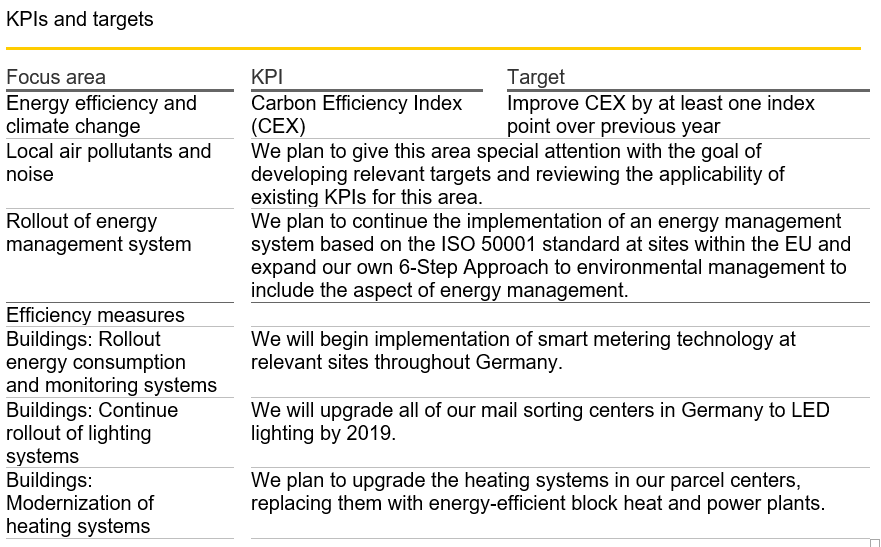GoGreen DHL!
The transportation sector which also includes logistics industry is responsible for 23% energy-related greenhouse gas emission globally. DHL's GoGreen environmental protection program has increased its carbon efficiency by 25% since 2007 by the end of 2015.
The transportation sector which also includes logistics industry is responsible for 23% energy-related greenhouse gas emission globally1. As the largest logistics service provider, DHL is expected by the public, its customers and shareholders to take active measures to minimize its negative impact on environment.
How DHL is likely to be affected by climate change?
DHL’s main environmental impact is its greenhouse gas emission (primarily CO2) as well as local air and noise pollution. As the emission standards for automotive industry and requirements for the use of renewable energy is becoming stricter in EU, DHL needs to react to change the way its large fleet of vehicles operates. The company set a goal in 2007 to improve CO2 efficiency by 30% company-wide by 20201. This is a challenging target as the company needs to use its vehicles more efficiently to deliver an increasing amount of cargo facing significant growth in e-commerce globally. DHL also needs to comply with Greenhouse Gas Protocol to calculate its emissions and the requirements of the European Emissions Trading System.
What are the steps DHL has taken to address the environmental issues?
DHL has initiated GoGreen environmental protection program to address not only the emissions generated by its own fleet but also their transportation subcontractors which actually account for the majority of the group’s overall emission. Two core principles when prioritizing the various environmental protection measures are focusing on measures that has the largest energy efficiency gains, and trying to reduce energy consumption before turning to alternative fuel sources. The measures taken by the company include
- Developing and deploying innovative technologies across fleet, offices and facilities.
- Transition into alternative fuel and adding electric cars into its fleet. DHL even purchased an electric vehicle manufacturer so that it can add such vehicles faster to its fleet which now has 13,500 electric cars worldwide in its network.
- Optimizing carbon efficiency for delivery routes and networks.
- Increasing environmental awareness of employees across the world.
Green products for customers. DHL provides standardized products as well as customized support for environmentally-optimized logistics solutions.
- Carbon reports help customers to calculate the emission their businesses have and gain deeper understanding of their impact on environment.
- Climate neutral products provide customers chances to offset their emissions by contributing to DHL’s climate protection projects.
- Green optimization products help customers to reduce their emission by designing customized logistics solutions after analyzing every link of the customers’ supply chain.
In addition to greenhouse gas emission, GoGreen addresses other environmental issues such as natural resources consumption, as well as local air and noise pollution. As of the latest reporting year, DHL’s environmental protection measures have led to 25% improvement in carbon efficiency comparing to 2007. Figure 1 illustrates DHL’s progress over the past years and Figure 2 shows future targets, both of which are from company website.
Figure 1
Figure 2
What are some future suggestions to DHL?
Develop new technologies in drone delivery or partner with leaders in relevant space for last mile delivery.
- Last mile delivery is where carbon efficiency is the lowest as it is hard to leverage the same route to deliver a large quantity of packages at the same time if meanwhile the company wants to ensure timely delivery. Thus on a per package basis, greenhouse gas emission in the last mile is probably the highest in the whole logistics process. Same applies to package pick up. If the company could instead use drones for these process, it will reduce the use of automobiles and thus carbon emission.
Use eco-friendly packaging or even reusable packages
- Postage service creates trillions of packages each year. The pollution during the production and disposal of cardboard box and the damage to forest resources is enormous. Eco-friendly or reusable packaging can help to reduce pollution and use of trees.
- Company website
(799 words)





I agree with you 100% that the “Last Mile” will be the biggest challenge for DHL as it strives to reduce its GHG/package because of the rapid loss of economies of scale. In addition to your drones suggestions, what are your thoughts on them partnering with a 3rd party company (ex. Uber or Lyft) that would handle the last mile on their behalf? The other idea I had would be a joint venture with other large logistics companies (UPS, FedEx) that handled the last mile for all of the major package delivery services in order to build some economies of scale back into the system.